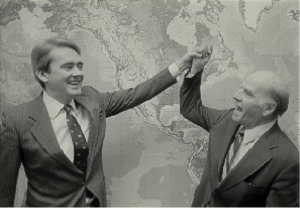In 1975, when I was ten years old, my parents drove my three older brothers and me down to Sandusky, Ohio, to Cedar Point Amusement Park. We lived just north of Detroit, and Sandusky was only an hour south as the crow flies. Lake Erie borders that corner between Michigan and Ohio, so we had to drive two and a half hours to bend around the huge lake. I remember driving down I-75, the mid-August humidity filling our station wagon like a bag of wet cement. There was no escaping the heat; air conditioning was not standard in those days, neither were seat belts. I was the youngest, so I sat in the way-back of our Ford LTD station wagon. From there, I stared at the great lake, which emerged into view shortly after traveling through downtown Detroit. Growing up in Michigan, I thought all lakes were giants. Lake Erie is the smallest of the Great Lakes, and yet it stayed in view for the entire last hour of our drive to Sandusky.

Our family made the trip to Cedar Point every summer. We went there to ride the roller coasters, especially the Blue Streak, which was the fastest wooden roller coaster in the country. Every year, we would arrive at the park in the blaring heat of summer to spend the entire day walking the paved pathways, the heat radiating up from the pavement through my white Keds sneakers. In contrast to the frenzy of the tall roller coasters whizzing around and the black pavement radiating heat, there was a long, sandy beach that paralleled the huge parking lot of the park. Lake Erie’s waves rolled back and forth onto the deserted sands. The entrance to the beach was barricaded with a chain-link fence and signs that read NO SWIMMING. I remember that this confused me as a kid. Why were we spending all day sweating in the heat when we could be swimming in Lake Erie? The answer was that Lake Erie, like many of the other Great Lakes, was polluted. Unfortunately, I grew up thinking pollution was normal. The Rouge River was one of the most notoriously polluted rivers in the country, although I didn’t know it as a kid; I only knew it as the river down the street from my house. We weren’t allowed to swim there either.
I was too young to know it at the time, but just five years earlier, on April 22, 1970, the very first Earth Day sparked a movement that would eventually clean up the waters of Lake Erie and the Rouge River, along with most of the major waterways in the U.S. Prior to 1970, there was “no EPA, no Clean Air Act, no Clean Water Act. There were no legal or regulatory mechanisms to protect our environment. In spring 1970, Senator Gaylord Nelson created Earth Day as a way to force this issue onto the national agenda. Twenty million Americans demonstrated in different U.S. cities, and it worked!”1
The Environmental Protection Agency (EPA) had been created in December of 1970, but Senator Nelson knew that in order to create the political will to empower the new EPA to enact significant changes, there needed to be a mass movement from people all over the country that made it clear they wanted their government to do something about the degradation of the environment. “The reason Earth Day worked,” Senator Nelson said, “is that it organized itself. The idea was out there and everybody grabbed it. I wanted a demonstration by so many people that politicians would say, ‘Holy cow, people care about this.'”2
Between 1970 and 1980, the U.S. Congress enacted all of the following pieces of legislation to protect the environment: the Clean Air Act, Water Quality Improvement Act, Water Pollution and Control Act Amendments, Resource Recovery Act, Resource Conservation and Recovery Act, Toxic Substances Control Act, Occupational Safety and Health Act, Federal Environmental Pesticide Control Act, Endangered Species Act, Safe Drinking Water Act, Federal Land Policy and Management Act, and Surface Mining Control and Reclamation Act3.
Today, Earth Day is celebrated around the world thanks to Gaylord Nelson and all who have stood up for the protection of the environment over the years. “In 1970, scientists told us that Lake Erie was dying and that the other Great Lakes were threatened by pollution from the steel plants, oil refineries, paper mills, and city sewage plants which for the previous one hundred years had befouled the world’s largest fresh water system.”4 Today, Lake Erie’s beaches are open to the public, and visitors to Cedar Point can cool off in its cool blue waters. Happy Earth Day!
References
1. Gaylord Nelson, EPA Archive, Earth Day ’70: What It Meant, EPA Journal – April 1980, “How Did Earth Day 1970 Change the Nation?” accessed April 4, 2017, https://archive.epa.gov/epa/aboutepa/earth-day-70-what-it-meant.html.
2. Keith Schneider, “Gaylord A. Nelson, Founder of Earth Day, Is Dead at 89,” New York Times, July 4, 2005, accessed April 7, 2017, http://www.nytimes.com/2005/07/04/politics/gaylord-a-nelson-founder-of-earth-day-is-dead-at-89.html?_r=0.
3. Gaylord Nelson, “The First Earth Day in April 1970,” EPA History: Earth Day, accessed April 1, 2017, https://www.epa.gov/history/epa-history-earth-day.
4. Gaylord Nelson, “The First Earth Day in April 1970.”
5. EPA History: Earth Day, “The First Earth Day in April 1970,” https://www.epa.gov/history/epa-history-earth-day.
Beth Man
Contributor
